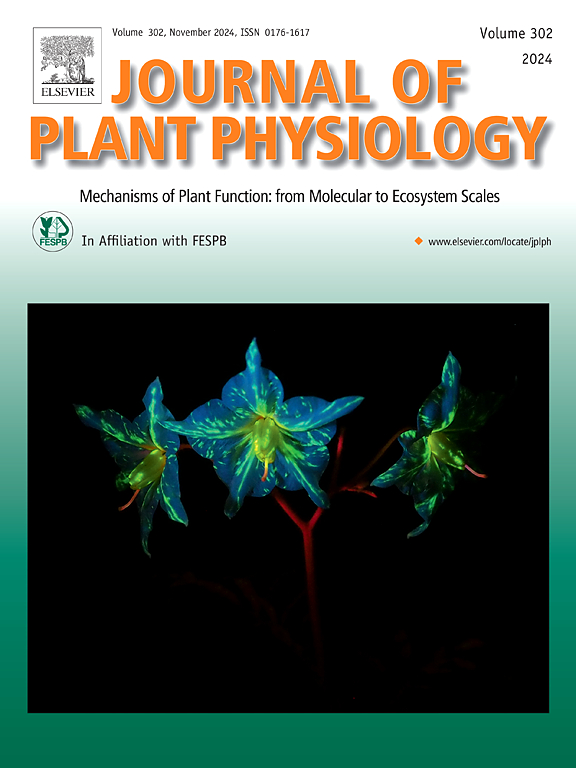Salinity-induced changes in the PSII/LHCII phosphorylation and organization of the photosynthetic protein complexes in the halophyte Mesembryanthemum crystallinum L
IF 4.1
3区 生物学
Q1 PLANT SCIENCES
引用次数: 0
Abstract
Halophytes have been widely used to investigate plant salt tolerance, but the mechanisms regulating photosynthesis under salinity are still poorly understood. Here, the effect of 10-day NaCl irrigation on the phosphorylation status of photosystem II (PSII), a light-harvesting complex of PSII (LHCII) and the organization of protein complexes in thylakoids of the halophyte Mesembryanthemum crystallinum L. (common ice plant) was investigated. In salt-acclimated plants, increased phosphorylation of LHCB1, LHCB2 and D1 proteins was observed under dark and light conditions. This was accompanied by reduced capability to perform state transitions in response to different light quality, as inferred from changes in the steady-state chlorophyll a fluorescence. Low-temperature chlorophyll fluorescence emission spectra revealed decreased PSII fluorescence in the dark and light in salt-acclimated plants, with a significantly smaller decrease of PSI fluorescence in the dark than in well-watered controls. These data indicate, that salinity reduces nocturnal LHCII disconnection from PSI, resulting in a permanent State II. The decrease in the functional PSII antenna in salt-acclimated plants was confirmed by the parameters of the fast kinetics of chlorophyll a fluorescence. Furthermore, blue native polyacrylamide gel electrophoresis revealed salinity-induced partial disassembly of PSII supercomplexes. Our results show that changes in the PSII/LHCII phosphorylation levels and the organization of thylakoid protein complexes play a role in acclimation to salinity in this halophytic species.
盐生植物中PSII/LHCII磷酸化和光合蛋白复合物组织的变化
盐生植物已被广泛用于研究植物的耐盐性,但对盐胁迫下光合作用的调控机制仍知之甚少。本研究研究了10 d NaCl灌洗对盐生植物Mesembryanthemum crystinum L.(普通冰植物)光系统II (PSII)磷酸化状态、PSII捕光复合物(LHCII)和类囊体蛋白复合物组织的影响。在盐驯化植物中,光照和黑暗条件下,LHCB1、LHCB2和D1蛋白的磷酸化水平升高。这伴随着对不同光质量的响应进行状态转换的能力降低,这是从稳态叶绿素a荧光的变化中推断出来的。低温叶绿素荧光发射光谱显示,盐驯化植物的PSII荧光在黑暗和光照条件下均有所下降,且黑暗条件下PSI荧光的下降幅度明显小于水分充足的对照。这些数据表明,盐度减少了夜间LHCII与PSI的断开,导致永久状态II。叶绿素a荧光快速动力学参数证实了盐驯化植物功能PSII天线的减少。此外,蓝色天然聚丙烯酰胺凝胶电泳显示盐度诱导PSII超配合物部分解体。我们的研究结果表明,PSII/LHCII磷酸化水平的变化和类囊体蛋白复合物的组织在这种盐生植物对盐度的适应中起作用。
本文章由计算机程序翻译,如有差异,请以英文原文为准。
求助全文
约1分钟内获得全文
求助全文
来源期刊

Journal of plant physiology
生物-植物科学
CiteScore
7.20
自引率
4.70%
发文量
196
审稿时长
32 days
期刊介绍:
The Journal of Plant Physiology is a broad-spectrum journal that welcomes high-quality submissions in all major areas of plant physiology, including plant biochemistry, functional biotechnology, computational and synthetic plant biology, growth and development, photosynthesis and respiration, transport and translocation, plant-microbe interactions, biotic and abiotic stress. Studies are welcome at all levels of integration ranging from molecules and cells to organisms and their environments and are expected to use state-of-the-art methodologies. Pure gene expression studies are not within the focus of our journal. To be considered for publication, papers must significantly contribute to the mechanistic understanding of physiological processes, and not be merely descriptive, or confirmatory of previous results. We encourage the submission of papers that explore the physiology of non-model as well as accepted model species and those that bridge basic and applied research. For instance, studies on agricultural plants that show new physiological mechanisms to improve agricultural efficiency are welcome. Studies performed under uncontrolled situations (e.g. field conditions) not providing mechanistic insight will not be considered for publication.
The Journal of Plant Physiology publishes several types of articles: Original Research Articles, Reviews, Perspectives Articles, and Short Communications. Reviews and Perspectives will be solicited by the Editors; unsolicited reviews are also welcome but only from authors with a strong track record in the field of the review. Original research papers comprise the majority of published contributions.
 求助内容:
求助内容: 应助结果提醒方式:
应助结果提醒方式:


